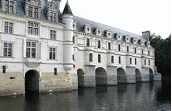|
The museum is housed in a late Gothic mansion, which is called
the Hôtel de Cluny that was erected toward the end of the 15th century by the abbot of
Cluny as a house for his order, and hence why the museum is often called the Musée de
Cluny, rather than by the official name of Musée National du Moyen Âge.
The mansion and its Gothic chapel became property of the State of France back in 1843 and
you will be able to see medieval architectural fragments and historically accurate
plantings contained within the garden, plus the ruins of baths which are believed to have
been part of an ancient Roman palace that stood on the site years before the Hôtel de
Cluny was ever built.
The Hôtel de Cluny and the Hôtel de Sens in the Marais area of Paris are all that remain
of domestic medieval architecture in Paris today and
as you enter through the cobblestoned Cour d'Honneur also known as the Court of Honour,
you can see the impressive Gothic building with its turreted walls, gargoyles, and
dormers.
The Hôtel de Cluny was originally the mansion of a rich 15th century abbot but by the
year 1515 it became the residence of Mary Tudor, who was widow to King Louis XII and
daughter of King Henry VII and Elizabeth of York. Yet by the time it came to the
French Revolution the mansion was seized and then rented to Alexandre du Sommerard in
1833, who adorned it with medieval artworks and it was after his death in 1842 that the
government purchased the building and its entire collection.
The collection of medieval arts and crafts within this museum is fantastic and yet most
people will come away referring to the set of six stunningly coloured Lady with the
Unicorn tapestries, which are the most acclaimed tapestries of their kind and were only
discovered around a century ago in the Château de Boussac in Limousin.
Some of the other exhibits within the museum include sculptures, statues from
Sainte-Chapelle, 13th century crosses, chalices, manuscripts, carvings, leatherwork,
jewellery and coins.
Also during Tiberius's reign, a column to Jupiter was found beneath Notre-Dame's chancel
and is now on view in the Court of Honour, which is called the Column of the Boatmen and
it is believed to be the oldest sculpture created within the City of Paris.
There is a guide in English that provides a plan of the museum and while you are wandering
around make sure you look out for the laminated information sheets that are provided in
English as well as in French.
The Musée National du Moyen Âge is on two levels and is a treasure of medieval art and
tapestries and provides a perfect setting for the large carved stone fireplaces, little
chapel and the intricately bricked Gallo-Roman baths that are filled with sculptural
fragments.
There is also a very pleasant, but often crowded public park behind the museum, which is
free to enter and has been designed to resemble a medieval garden and there is even a
childrens playground within it, so it is a great place to take the family and you will be
sure to enjoy this museum.
There are also regular concerts of medieval and renaissance music held within the museum,
so before you plan your visit, it may be an idea to find out if there are any planned
whilst you are in Paris on holiday in France.
Guided tours for groups can be arranged, but these must be booked in advance and it is
wise to allow at least one to two months prior in organising this type of tour.
There are also audio guides available for hire in different languages and there is a gift
shop on site.
The museum is open on Wednesday through to Monday from 9.15am to 5.45pm but is closed on a
Tuesday and national holidays.
Address & Contact Details:
6 Place Paul-Painlevé
75005
Paris
France
Telephone: 1 53 73 78 00 or telephone reception on 1 53 73 78 16
|
|



